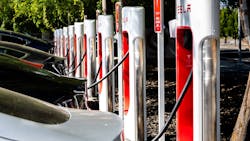So That Happened: EV Drivers Still Unhappy With Public Charging
Editor’s note: Welcome to So That Happened, our editors’ takes on things going on in the manufacturing world that deserve some extra attention. This will appear regularly in the Member’s Only section of the site.
New Contest for Legacy Lift Trucks
Intella Parts Company, supplier of aftermarket forklift parts, has announced the “Oldest Raymond Forklift Contest.” Open to businesses and individuals with in-use or retired vintage Raymond lift trucks, the nationwide campaign is looking for owners and operators to share and celebrate the history of Raymond equipment.
“We work with thousands of customers who rely on Raymond forklifts every day. Many of them have older models still going strong, and we thought it would be fun to recognize that dedication,” said Marcel VandenTop, president of Intella Parts. “This contest is our way of honoring the legacy of Raymond forklifts and the teams that maintain them.”
To enter the contest, submit photos of your Raymond forklift along with its model, year, serial number and any known history, stories or facts about the equipment to [email protected]. If possible, include a picture of the data plate with your submission.
According to the Intella Parts website, winners have the chance to receive a $100 VISA gift card, a $100 gift certificate for Intella Parts and, of course, bragging rights. Entries are open through Sept. 8.
—Anna Smith
Digitalization Lights the Dark Ages
I recently spoke with Andreas Widl, CEO and COO and CEO of German valve manufacturer Samson AG, a “middelstand” company (a German word for family-owned SMBs) based in Frankfurt.
Widl went to Israel on a startup safari, looking for technologies to increase Samson’s innovation and agility. He discovered a company called 3D Signals that develops machine monitoring algorithms.
The shop floor at Samson’s Frankfurt plant was completely unorganized, a dark zone for data. No one could tell Widl at a moment’s notice which machines were running because none of the machines were connected.
Two investments of €500,000 later, Samson AG wound up with a minority position in 3D Signals and a robust, sensor-agnostic system that could sense the running status of his machines and what product they were manufacturing at any given time.
Cutting down on machine idle time and instituting a more logical tooling changeover schedule led to a 30% efficiency increase and €60,000’s worth of electricity cost savings at Samson’s plant in Frankfurt.
Now Widl either installs the new system at Samson plants that lack machine monitoring or, for plants that already have machine monitoring software, makes sure they port their data into the 3D Signals algorithm.
Widl said it only took an hour to prep the Frankfurt plant’s ethernet cable layout and 45 minutes to wire all the machines at the plant with sensors. The impetus for the project came from Widl himself, so buy-in wasn’t an issue. The data was very clear, which made the appropriate course of action to increase efficiency also clear.
Manufacturers can only wish it was always this easy to tap into the power of simple data collection and algorithmic analysis.
—Dennis Scimeca
Toyota Tackles Child Care Dilemma
Lack of child care can be a big factor in working parents’ abilities to reliably show up to work, and it can keep otherwise willing parents out of the workforce altogether. Toyota has long recognized and responded to this challenge: The automotive manufacturer has offered day care at its largest global site in Georgetown, Kentucky, since 1993 and at its Princeton, Indiana, manufacturing location since 2023.
Toyota is now doubling down on its child care offerings. The company will add child care centers at manufacturing plants in North Carolina, Mississippi, Alabama and West Virgina. The Liberty, North Carolina, site opened in August, and the Mississippi child care center opens this fall, with the other two scheduled to open in 2026 and 2027.
Developed in collaboration with a third-party provider, each of the four centers will care for more than 200 children over two shifts. Moreover, the child care centers will introduce age-based curriculum for children six weeks to 5 years old.
“At Toyota, we know it is paramount for working parents to have access to quality childcare, and manufacturing is not always a nine-to-five job,” said Denita Neville, vice president of Toyota’s Corporate Shared Services.
—Jill Jusko
14% of EV Visits to Public Chargers End with No Juice: Hurray for Progress!
One-in-seven people pulling their electric vehicles up to a charging station, only to find all spots occupied or the charger stripped for copper doesn’t sound great, but it’s an improvement from nearly one-in-five charging failures a year ago.
One of the most common reasons that buyers in surveys give for not buying electric cars is fear that they won’t easily be able to recharge them. While most EV owners charge at home, having access to Tesla Superchargers or offerings from dozens of other providers is an important measure for public comfort.
Unfortunately, EV chargers have been plagued with unreliability due to poor maintenance, vandalism and even some gasoline-powered vehicles protesting electrics by parking in charging spots. In its annual look at driver satisfaction with public charging, J.D. Power researchers say experiences are getting better, but drivers are still largely unsatisfied with public charging.
While drivers are successfully charging more often, power prices are up (on a personal note, I’m used to paying very little for charging at home or at work, but my few visits to public chargers leave gasoline fill-up-like expenses).
“While the expansion of DC fast chargers remains important, the data strongly indicates that increasing speed alone is not the solution to public charging challenges,” Brent Gruber, executive director of the EV practice at J.D. Power, said. “Improving reliability, ease of use and addressing cost concerns are among a multitude of factors at play that must be prioritized to enhance the overall public EV charging experience. Faster does not always mean better.”
—Robert Schoenberger
Good News … for Robots
Some positive news on the manufacturing-orders front: North American robot orders increased by 4.3% in the first half of 2025. Automotive OEMs led the charge with a 34% year-over-year increase in orders, followed by plastics and rubber (up 9%) and life sciences/pharma/biomed (8%). The association did not share percentages for the United States only.
Alex Shikany, executive vice president at the Association for Advancing Automation, said in a statement that if the trend holds, the North American robotics industry could outperform 2024 by single digits by year’s end.
The association just started tracking cobots as their own category at the start of 2025. In the second quarter of 2025, cobots accounted for 14.7% of sales and 23.7% of units sold.
—Laura Putre
About the Author
Anna Smith
News Editor
News Editor
LinkedIn: https://www.linkedin.com/in/anna-m-smith/
Bio: Anna Smith joined IndustryWeek in 2021. She handles IW’s daily newsletters and breaking news of interest to the manufacturing industry. Anna was previously an editorial assistant at New Equipment Digest, Material Handling & Logistics and other publications.
Robert Schoenberger
Editor-in-Chief
LinkedIn: linkedin.com/in/robert-schoenberger-4326b810
Bio: Robert Schoenberger has been writing about manufacturing technology in one form or another since the late 1990s. He began his career in newspapers in South Texas and has worked for The Clarion-Ledger in Jackson, Mississippi; The Courier-Journal in Louisville, Kentucky; and The Plain Dealer in Cleveland where he spent more than six years as the automotive reporter. In 2014, he launched Today's Motor Vehicles (now EV Manufacturing & Design), a magazine focusing on design and manufacturing topics within the automotive and commercial truck worlds. He joined IndustryWeek in late 2021.
Dennis Scimeca
Dennis Scimeca is a veteran technology journalist with particular experience in vision system technology, machine learning/artificial intelligence, and augmented/mixed/virtual reality (XR), with bylines in consumer, developer, and B2B outlets.
At IndustryWeek, he covers the competitive advantages gained by manufacturers that deploy proven technologies. If you would like to share your story with IndustryWeek, please contact Dennis at [email protected].
Jill Jusko
Bio: Jill Jusko is executive editor for IndustryWeek. She has been writing about manufacturing operations leadership for more than 20 years. Her coverage spotlights companies that are in pursuit of world-class results in quality, productivity, cost and other benchmarks by implementing the latest continuous improvement and lean/Six-Sigma strategies. Jill also coordinates IndustryWeek’s Best Plants Awards Program, which annually salutes the leading manufacturing facilities in North America.
Have a story idea? Send it to [email protected].

Laura Putre
Senior Editor, IndustryWeek
As senior editor, Laura Putre works with IndustryWeek's editorial contributors and reports on leadership and the automotive industry as they relate to manufacturing. She joined IndustryWeek in 2015 as a staff writer covering workforce issues.
Prior to IndustryWeek, Laura reported on the healthcare industry and covered local news. She was the editor of the Chicago Journal and a staff writer for Cleveland Scene. Her national bylines include The Guardian, Slate, Pacific-Standard and The Root.
Laura was a National Press Foundation fellow in 2022.
Got a story idea? Reach out to Laura at [email protected]





